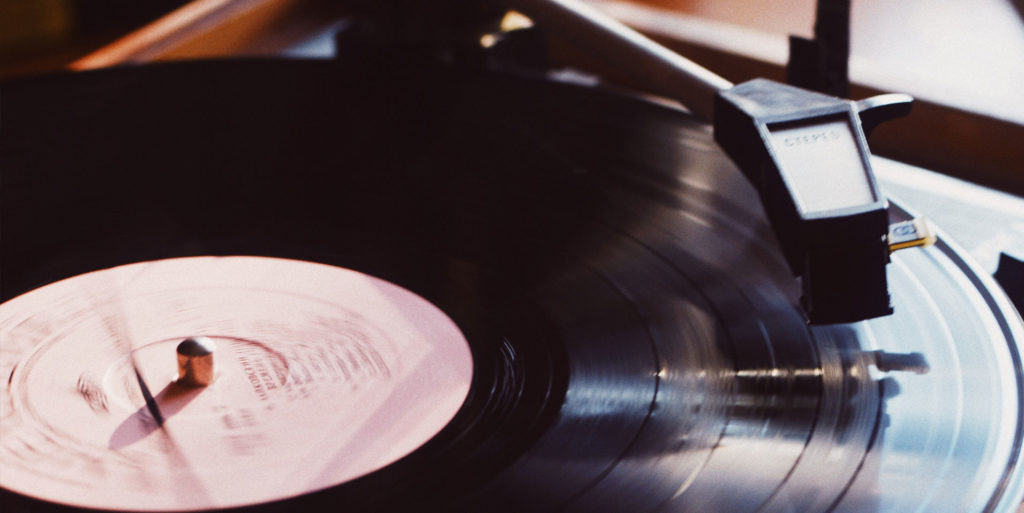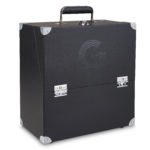When first starting out on our vinyl record collecting journey it can certainly be most confusing to have to navigate such an intense field of new terminology. So democratised and user led is this community that new terminology and slang arises all the time and is, in fact, part of the very fabric of this hobby and all the subcultures related to it.
Regardless of whether the linguistic complexity or the various specificities are of interest to you, all those intending to accrue a vinyl record will need a resource like this, at least to begin with: a guide to vinyl record sizes that helps the beginner to wrap their heads around just what all the various sizes mean, for the user and for audio quality and beyond.
The size of a record is very much tied up with the speed at which it is played. Since Thomas Edison laid out the first blueprints for a phonograph in the 1800s, we’ve come a long way in how we capture, record, produce, release, and distribute music, and yet here we still are talking about this primitive recording technology, outlining here this guide to vinyl record sizes for you to consume.

Vinyl Record Sizes in a Nutshell
While there are doubtlessly plenty of different shapes and sizes which a vinyl record can come in, plenty which have manufactured in response to the typical circle shape and the homogenous three sizes that typically abound in the mainstream of vinyl collecting, these three sizes remain omnipotent.
So much of this is to do with money. Sure, let someone like Thurston Moore of Sonic Youth release a limited edition release in the shape of a marijuana leaf, but the limited release speaks for itself. It’s all well and good, but is largely an inconvenience to play on a format designed to be circular.
If we take these three standard sizes – the 12 inch, the 10 inch and the 7 inch – and weigh them up with the rpm (revolutions per minute) that they typically run at, we can see that more often than not the larger a disc is the less rpm it is supposed to run at and vice versa.
There is an increasing trend for 12 inch records and the like to be mastered at half speed, meaning an overall better sound quality throughout the recording but also meaning that the record will need to be played at 45rpm. This is the case for newer pressings of Brian Eno’s Discreet Music which the listener will have to flip over at the halfway point to enjoy the whole eponymous ambient piece. So, anyone looking to listen to such recordings and bliss out is going to be at least a little peaved.
12 inch Records
This size of record will more often than not house a recording of an album, typically one half allotted per side of the physical disc. It is more often the case, also, that these albums will be played at 33 1/3 rpm, as this means there is more space on the record to contain the music which is being released in this longer form, able as a record is to hold roughly 15 to 22 minutes of music per side.
However, there are artists and companies who release singles on this format too. Since a song’s quality is inherently ‘better’ at 45 rpm, disc jockeys soon found they favoured this format though found the size of 7 inch records limiting. However, with a 12 inch single allowing up to 15 minutes of run time at 45 rpm, these very same disc jockeys quickly gravitated to such a medium.
This extension of the single format also allowed longer mixes of songs to be released too, not to mention allowing the existence of the EP (extended play) format and various singles featuring remixes by other artists alongside the original version of a song. This format became immensely popular for the release of rap and hip hop singles, for example, because the extra space on board allowed the instrumental as well as the original to be included, meaning fans could rap along and even freestyle over the top if they wished.
10 inch Records
This will be one of the rarer types of record that you will encounter in the wild, excusing those kind of novelty or limited edition records mentioned previously, and one of those types of records that, as a guide to vinyl record sizes, I can safely you won’t see as much of as its 12 inch and 7 inch brethren.
In being such an inbetween size, many disregard its uses, simply seeing it as not very useful at all in fact. With a run time of 12 to 15 minutes at 33 1/3 rpm and 9 to 12 minutes at 45 rpm, there are no doubts as to the liminality of the medium. However, in an age where attention spans are getting shorter and shorter, this is perhaps not a bad thing.
After the single, the EP seems like the most appropriate release format for artists, able as it is to house a cohesive collection of songs without over staying its welcome. Artists like Earl Sweatshirt have cottoned on to this idea, in his case making a point of excusing the 3rd verse of his rap songs in favour of a shorter run time, to cater for shorter attention spans and a faster world with different dynamics.
7 inch Records
The smallest of the more common vinyl record sizes in this holistic guide to vinyl record sizes, this lack in size ought not translate to an overall lack of presence, for they can be found everywhere. Typically played at 45 rpm for the sake of audio quality, they are the perfect size for holding a single song on each side (depending on the length of the songs in questions of course), able to capture 4 to 6 minutes on each side, with the run time increasing to around 7 minutes if played at 33 1/3 rpm.
Coming into prominence as a fantastic alternative to the vulnerable and flimsy shellac records, which themselves were bound to the 78 rpm speed that many of these record sizes, 10 inch excluded, were attempting to move away from. They have since become a wide spread way for everyone from the average music fan and listener to the most professional disc jockey to transport and listen to their favorite music.
Final Tones
So, there you have it, a comprehensive and, I hope, informative guide to vinyl record sizes, allowing you to navigate them with ease and to converse as you might with fellow enthusiasts and collectors.
FAQs Guide to Vinyl Record Sizes
Most records will label this very clearly in the centre of the record on a sticker. Without much visual indication, however, this can be a bit of a problem, though shouldn’t be so if you know the record well enough, how it should sound normally. I’ve had this problem plenty of times with records, where I listen to it at the wrong speed for long enough without realising that it sounds wrong at the right speed. By rule of thumbs a 7 inch record will tend to be listened to at 45 rpm and a 12 inch at 33 1/3, though the latter rarely so if it is a 12 inch single.
Purely in how they are pressed. The faster a record plays and is mastered, the better the sound quality, and this decision is largely down to those in charge of these processes, informed as they are by the various limitations of the format. Many records are, in fact, pressed in varying speeds throughout their history of issues and reissues. A 33 rpm record is played at 33 rpm, a 45 at 45 rpm, and 78 at 78 rpm etc etc.
The size shouldn’t really matter, the choice should lie in the record that you are buying in the first place. In the very rare case that you are looking to buy a specific song and are offered the choice to do so on, say, a 7 inch record or a 12 inch record, it’s really down to your own preferences, but shouldn’t be hindered by corporeal limitations. Every record player has the capacity to play any one of these formats.
Records are pressed at different speeds purely because of the response of the varying lengths and frequencies of certain recordings to the vinyl format itself. Some recordings will lend themselves to certain vinyl record sizes than others and vice versa. The whole process is about the response of these specific recordings to the various limitations of the format.







